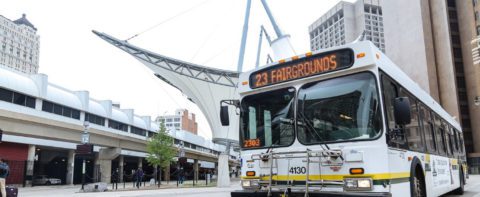For more than 100 years, the Detroit region’s well-connected transportation infrastructure has served the automotive industry’s supply chain and is positioned to become the next transportation logistics hub. With a vastly integrated highway and freeway system, seven international border crossings, five major airports, several airfields, four public transportation authorities, a deep-water marine port and eight rail yards, people and goods move easily throughout the region, United States, and North America.
Transportation Infrastructure
Maps
Provided by the Michigan Department of Transportation.

Interstates
- I-75 runs north from Florida to Michigan’s Upper Peninsula.
- I-94 runs west from Port Huron, through Detroit, to Montana.
- I-96 runs northwest from downtown Detroit to Grand Rapids and Muskegon.
Airports
- Bishop International Airport (Flint) – General aviation and air cargo services provided by national airlines.
- Detroit Metropolitan Wayne County Airport (Romulus) – General aviation and air cargo services provided by 16 major national and international airlines.
- Coleman A. Young International Airport (Detroit) – A Class C gateway airport that provides general aviation and air cargo services.
- Oakland International Airport (Waterford) – Provides private and corporate aircraft and aviation services for all the Fortune 500 companies.
- Willow Run Airport (Ypsilanti) – Provides corporate, cargo, and general aviation services.
Border
The Detroit region offers three passenger border crossings into Canada. For information on documentation regarding crossing the border, read the U.S. Custom’s and Border Protection information.
- The Ambassador Bridge – Located in Southwest Detroit, the bridge is North America’s busiest border crossing serving the U.S. and Canada.
- The Detroit-Windsor Tunnel – Located in downtown Detroit, the tunnel serves as an alternative to the Ambassador Bridge.
- Blue Water Bridge – Connects Port Huron, Michigan to Sarnia, Ontario and serves as a critical gateway linking the U.S. and Canada.
Port of Detroit
- Fully equipped marine terminals that handle general, liquid, and bulk cargo. The port also serves passengers.
- Terminals are located in Detroit, River Rouge, and Ecorse.
- For a complete list of port services, view the latest edition of Detroit Ocean Shipping Guide through Port Detroit.

Public Transit
- QLine – Operated by M1-Rail, the QLine is Detroit’s newest public transit system, featuring streetcars that connect the city’s north end to downtown via a 6.6-mile loop along Woodward Ave.
- The City of Detroit Department of Transportation (D-DOT) – The largest public transit agency in Michigan offers more than 50 routes in the city of Detroit.
- Suburban Mobility Authority for Regional Transportation (SMART) - Offers 55 routes serving Wayne, Oakland and Macomb counties.
- The Ann Arbor Area Transportation Authority (AAATA) - Offers 27 routes serving Washtenaw County.
- The People Mover – A 2.9-mile elevated system serving downtown Detroit. The system travels in a continuous loop around the downtown area with 13 stops.

Learn about the region’s economics, workforce and talent, industry clusters and more.
For additional information, contact the Data and Research team.
Contact Us



